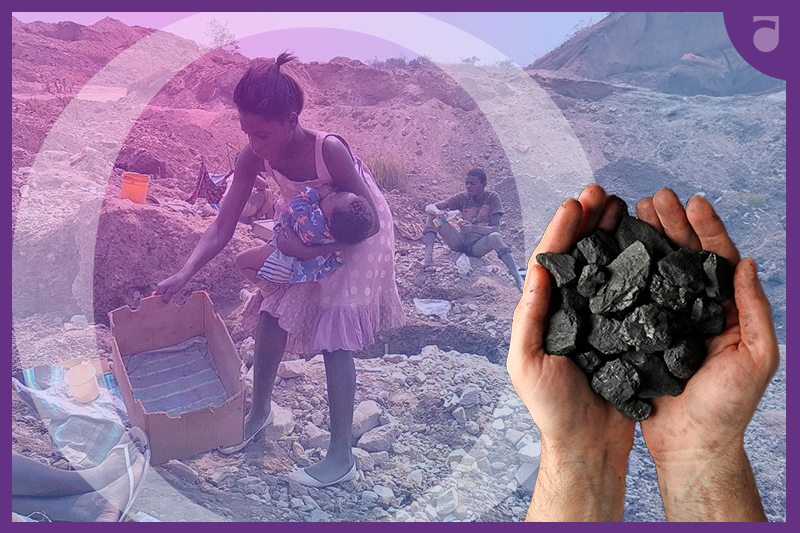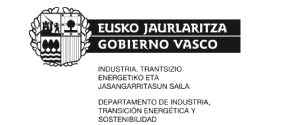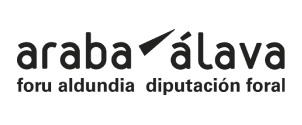Cleaning and loading minerals during long, exhausting and poorly paid working days. Maybe in direct contact with toxic substances that put your health at risk. Perhaps carrying a baby on your back while you work. In a group, to be protected, as the risk of sexual assault is very real. Knowing that your loved ones are likely to suffer serious injuries or illnesses, some disabling for life, or die buried in those dark tunnels where men and boys go in aiming to subsist. A situation of enforced solitude that would only increase your vulnerability to all of the above.
This description summarises the possible situations experienced by thousands of women working in "artisanal" cobalt mining(1) in the Democratic Republic of Congo (DRC), the country that accounts for most of the world's cobalt production(2). To speak of cobalt is to speak of a fundamental resource(3) for the digital and ecological transitions due to its multiple applications in strategic industries, including the manufacturing of rechargeable electric batteries (for mobile phones, computers, electric vehicles, etc.)(4). The high demand for cobalt from industrialised countries, combined with the concentration of easily accessible deposits in the DRC, has led to an intense mining activity in certain regions of the country. This has economic and geopolitical implications worldwide, but also environmental and social implications where cobalt is mined.
On the latter, it is well known that numerous organisations and researchers have exposed and documented how global cobalt supply is rooted in a tragic combination of precarious and high-risk working conditions, the use of child labour, forced or bonded labour, population displacement and widespread violence linked to armed conflicts in the DRC(5).
Distribution of the main cobalt deposits and mining areas in the DRC, on the country's border with Zambia. Corresponds to the provinces of Lualaba and Haut-Katanga (both formerly part of the historic Katanga region). Source: U.S. Geological Survey.
Among the works on this subject, many people reading this post will surely already be familiar with the book Cobalt Red(6), which contributes to this work of denouncing and disseminating information on the origins of cobalt. Its author, the writer and researcher Siddharth Kara (a specialist in human trafficking and forms of modern slavery), describes the trips he made to the DRC to learn about the reality of artisanal cobalt mining.
Kara's book focuses on the dangerous working conditions and the (unpunished) involvement of child labour in mining-related work, and how these phenomena underlie a chaotic network of intermediary agents at the beginning of the cobalt supply chain. Building on this topic, Kara's work also pays attention to the women the author meets at various points along his journey and who also play a role in cobalt mining, though an apparently secondary one. The situation of these women, according to Kara himself and other sources(7). represents an even more obscure facet in relation to cobalt. For this reason, the purpose of this post has been to gather and organise the cases and testimonies of women scattered throughout the text of Red Cobalt, to try to give them unity and strength and to contribute to giving visibility to this little-known reality.
It should be noted that, although this post focuses on Kara's experiences, other people have also documented their research in the field and paid special attention to the situation of women, such as Dorothèe Baumann-Pauly, Roy Maconachie or Benjamin Sovacool. I also recommend the reports "The Cobalt Pipeline" or "Blood Cobalt", which include videos and photographs that illustrate some of the scenes described in this post, such as the washing of minerals by women or the descent into the precarious mine tunnels.
The following are some of the stories behind the women in cobalt mining.
1. An active role for women
Artisanal cobalt mining is a heavily male-dominated sector, as it is the mining and processing of mineral resources worldwide. But women and girls are also part of the chain of tasks in artisanal cobalt mining.
Most of them do this by washing, sifting and sorting stones in ponds, lakes or rivers (laveuses) before filling sacks to sell the mineral to intermediary agents, as can be seen at several points in Kara's account. It seems common for this activity to take place within family structures or trust groups in which tasks are subdivided. Some of them have tools such as sieves, but Kara also meets girls washing rocks in streams without even having one and using raffia sacks to do so. Baumann-Pauly's research indicates that this primary role of washing ore may be due to some superstitions or traditional beliefs, according to which the presence of women in the excavations reduces the quality of the cobalt or even makes it disappear (some call them "snakes" or nyoka in Swahili).
However, there are also many women who dig or scavenge for cobalt. Kara meets some of them who are teenagers, carrying their babies on their backs or leaving them in cardboard boxes in the outdoors as they work, trying to reconcile their care with the harshness of the conditions. The little ones are often at risk of inhaling the dust created by the digging. As we will see later, pregnant women are also taking the risks of working on the mines.
A woman places her baby in a cardboard box as she works in the search for cobalt. Source: Siddharth Kara in The Independent.
2. Toxic working conditions
One of the main problems associated with working with minerals in an unsafe and unprotected manner is being exposed to toxic substances. In the case of women, this risk occurs mainly in ore washing work. Some of the women Kara talks to suffered from skin or stomach problems and described the water as "poison". The testimony of a woman who washes ore shows that exposure to toxic substances often leads to illnesses which, given the significant cost of available medicines, reduce the economic capacity of families (for example, to send their children to school). The severity of the consequences of this exposure can also lead to miscarriages or birth defects. Roy Maconachie’s research accounts for several of these effects, as well as the proliferation of malaria or typhoid fever in the washing sites.
Women washing ore for the sale of cobalt. Source: "Bloody Batteries", by Luca Catalano Gonzaga, in Witness Image.
As well as ore washing, Kara describes other forms of pollution affecting the local population, such as the dumping of effluent from concessions into rivers where women wash clothes, men fish and children play and splash about. He also talks about dust from industrial ore treatment processes, which is deposited on people and houses.
However, there are examples of how exposure to toxic substances can be reduced. Kara visits a couple of pilot projects in the Lualaba province designed to improve conditions of artisanal mining. While Kara discovers shortcomings, such as women not having protective equipment for washing ore, he finds evidence of improvements in sanitation, such as clean water supply, toilets and some protective equipment for women and men. There are significant asymmetries between the projects he visits, but a striking common element is the signs prohibiting entry to, among others, pregnant women, suggesting that this is a recurring situation in these types of operations. D. Baumann-Pauly's research shows the importance of these pilot projects, the failure of which disproportionately affects women more than men.
Sign prohibiting the entry of pregnant women, minors and carrying heavy loads at the Mutoshi mine (DRC) in December 2022. Source: Dorothèe Baumann-Pauly in SWI swissinfo.ch.
3. Unequal treatment for the same tasks
A guide tells Kara that the intermediary agents(8) always pay women less than men for the same amount of cobalt, so only women who work alone sell cobalt. This is then confirmed by a group of women who wash the ore in a lake and report that they do not get a fairer deal by selling directly at the stalls(9), where they are never offered more than 2% of the cobalt content of the ore, even though it is obvious that the percentage is higher. As a result, their income is barely more than a dollar a day, despite the hard ten-hour work days that are their only means of subsistence.
This partly explains why women participate in family or trust-based division of labour structures (so that it is men who sell the cobalt), although we will see below that this is not the only reason. The case of the adolescent girls with babies mentioned above also shows how women can delegate to men to sell the cobalt they collect and wash for them. However, this can happen when they do not have the means to transport the material themselves (partly due to caring for babies) and does not necessarily imply fairer treatment.
4. Spiral of vulnerability
The lack of livelihood alternatives is worsened by the situation that many families, or single women, face due to the death or illness of family members who bring home a significant income from mining, or due to situations of abandonment. Many mothers and grandmothers are left alone to raise children and grandchildren, which may force them to send children to work in artisanal mining. As Kara says, women are expected to run their households and take care of their children, despite the poverty wages and conditions of their jobs in cobalt mining. Sometimes if a widowed woman remarries, the new husband may kick the children from the previous marriage out of the house, leaving them to find a way to survive.
In addition, as we will see later on, many women are drawn into single motherhood as a result of being forced into prostitution or as a result of rape around cobalt mining operations. This is especially critical for girls or young women who, according to an OECD report, are particularly susceptible to being forced into prostitution or other forms of sexual violence in mining areas, being more common in relation to cobalt (40% of the cases of child labour in mining analysed by the report).
These factors only add to the drama of child labour that Kara investigates in cobalt mining. Child labour, in turn, carries a high risk of increasing women's loneliness and vulnerability, as in the collective accidents of tunnel collapses, there can be cases of parents and children working hand in hand and being buried together. Phrases such as "we work in our graves" or "our children are dying like dogs", which Kara recorded from the testimonies of some interviewees, clearly reflect the constant fear of fatal cave-ins that hangs over families dependent on artisanal mining.
A woman searches for cobalt with her children. Source: Michael Davie in Australian Broadcasting Corporation.
5. Sexual violence
By Kara's own admission, the sexual assault of women and girls is the most invisible and brutal part of the global cobalt supply chain, a scourge present in almost every artisanal mining area in the DRC visited during his research. A representative of the Lualaba provincial government, with whom Kara meets, openly confirms some of the facts about women in mining that have already been mentioned, such as unequal pay, lack of safety measures and, in particular, sexual violence.
The first indication of the seriousness of the problem comes when Kara speaks to a group of young women who wash ore. They explain that they work as a group to protect themselves from sexual assault by other miners, transporters and soldiers. All the members of the group assure Kara that they themselves know other women who have been assaulted in the cobalt mines, which Kara associates with the babies on the backs of some of the workers. Later, Kara meets another group of women washing ore in a lake, who explain that physical assaults by soldiers patrolling the area only add difficulties to the precarious working conditions. The protective attitude of family or trusted work units, especially among women, is a necessary element of sisterhood in such a hostile environment.
During his visit to the pilot projects, which aim to formalise and improve working conditions in artisanal mining, Kara confirmes with the testimony of some women that they feel safer working within this model. Although they do not specify that they do not suffer harassment, but rather 'less', for these women it is a clear improvement compared to working in other places where they were routinely exposed to various forms of harassment. According to one testimonial, this security would even compensate for the disadvantage of earning less money, showing the unfortunate dichotomy that some women face in "choosing" (if they can) one or another dignified way of working.
This exposure to sexual violence is increased or generalised when other factors come into play. In this regard, Kara's description of the village of Mupanja is a clear example of the unwanted social effects of artisanal mining, where the mining activity is very intense and has led to rapid population growth in the search for cobalt. A local fisherman explains how this has led to a considerable increase in violence, alcoholism and prostitution. It is an explosive mix for violence against women. In fact, Kara observes how the soldiers patrolling the area leer at the local girls.
In another part of the story that takes place in Kasulo (Kolwezi), a place that he defines as the peak of the population's feverish search for cobalt, Kara has the opportunity to visit a brothel. There he sees the conditions in which young girls, apparently as young as fourteen, were working as sex workers with miners who come to the brothel because "they want to celebrate, to feel alive" when they receive their wages. The situation was made worse by soldiers, who reportedly did not even have to pay. Also opaque is what happens in private entertainment clubs for Chinese intermediary agents, where no one is allowed on the premises (except for strippers). According to B. Sovacool, sex workers are particularly susceptible to poverty and violence, partly because many are migrants without a local support network.
6. A face that condenses all the misery
This phrase is used by Kara to refer to a particular case that makes a great impression on him. On the outskirts of Lake Malo, Kara comes across a fifteen-year-old girl who searches for cobalt by hitting the ground with a piece of rebar. This girl, whose name is Elodie in Kara's account, has a visibly sickly and dilapidated appearance that Kara associates with an advanced state of HIV infection. She works carrying her child on her back, a two-month-old baby who also appears to be in a weakened state of health. Elodie's mother apparently contracted a deadly infection washing ore in the lake. A year later, her father died in the collapse of a cobalt mining tunnel. To survive after being orphaned, she was forced into prostitution with miners and soldiers who denigrated her with impunity. She became pregnant and presumably contracted HIV. Her maternity situation also led her to desperately seek cobalt, but it was not enough, and she had to continue resorting to prostitution.
Elodie's case is particularly harsh because it brings together in a single story the combined effect of many of the factors of inequality and injustice that women endure in artisanal cobalt mining.
Girls and women search for cobalt and wash it. Source: Siddharth Kara in Daily Mail.
7. Beyond cobalt and the DRC
Cobalt is not the only mineral whose artisanal extraction is a source of inequality and violence for women. As the National Network of Women in Mining (Renafem) has pointed out, this occurs in different territories of the DRC with many other mineral resources. Indeed, it would be cynical to write about mineral resources, violence and women in the DRC and not to mention the recent wave of violence in the east of the country, with episodes such as the mass rape and murder of 165 women in early 2025, which is one of the latest events in a latent and often overlooked conflict that has been closely linked for decades to the mineral wealth of the DRC's subsoil.
Women find themselves in vulnerable situations wherever artisanal mining occurs, and this happens in a wide diversity of geographies. A World Bank report covers several case studies of women, from other African countries (South Africa, Nigeria, Sierra Leone, Rwanda, etc.) to South America (Peru, Colombia) or Asia (Mongolia, Philippines). As the demand for critical minerals grows with the ecological and digital transitions, the impact on vulnerable groups and women in different latitudes can be expected to increase.
Despite the magnitude of this problem, this should not be understood as an amendment to the ecological and digital transitions, particularly in the process of decarbonising the economy. Industrial and technological actors are progressively taking steps to control the supply of minerals (although the ineffectiveness of these initiatives to date is one of Kara's main complaints). One possibility is to recycle cobalt and other materials. For example, Apple has announced that all its batteries will use 100% recycled cobalt from 2025; or manufacturers such as Volvo see blockchain as a way to track the cobalt in their batteries. Above all, the development and marketing of new cobalt-free storage technologies will be key. In the Basque Country, CIC Energigune and Cidetec are examples of this. Another good example is the Chinese company BYD, which has also developed cobalt-free batteries.
However, while reducing consumption or imports has an important sense of efficiency, environmental sustainability and strategic autonomy, the elephant in the room will remain the same: the imperative need to improve working conditions at mining and processing sites, within a full value chain approach. On the one hand, because the demand for critical minerals such as cobalt will continue to grow, directly or indirectly affecting the people who have to work in artisanal mining. On the other hand, even the circular flow of minerals, once within developed economies, is likely to have an implicit social footprint that needs to be estimated and compensated for as far as possible. The examples of pilot programmes cited by Kara and described in detail by Dorothèe Baumann-Pauly, or the education, empowerment and emancipation programmes of Renafem, are examples of how the situation of women can be improved.
As S. Mosquera argues, social acceptance is a key factor in many facets of the deployment of renewable energy and other energy resources, such as electric vehicles. Such acceptance and increased social awareness can and should also encompass the value chains and the origin of resources, thereby demanding ethical and sustainable development of extractive industries. The search for better conditions in the specific case of women in the mining of critical raw materials could even be interpreted as a way of integrating the gender perspective into a holistic view of sustainable mobility or, more generally, the ecological and digital transitions.
There are multiple derivatives of the complexity of this issue that could be further explored. In the future, we hope to be able to continue working on them in this blog and within Orkestra's research line on critical raw materials(10).
- (1) Artisanal or small-scale mining is a form of informal mining, usually carried out by individuals or small groups, using basic tools without advanced techniques and with few safety measures. It is estimated that 8 or 9 out of every 10 people engaged in mining in the world belong to this category, which poses an immense challenge in terms of sustainable development.
- (2) In 2023, the DRC accounted for 74% of global supply and is expected to account for 66% by 2030. Artisanal mining accounts for 10-20% of DRC's total cobalt production, although these figures depend on estimates and the macroeconomic context (e.g. price and demand).
- (3) It is one of the so-called critical raw materials. M. Larrea wrote some related posts in this blog about the paradox that these raw materials constitute in the energy transition or the reduction of risks for their supply.
- (4) Essentially in lithium-ion batteries, which currently account for 90 % of the available battery market and the main reference technology for electric vehicles, according to the IEA. However, it is important to clarify that, according to the same IEA report, in 2023, cobalt used in batteries for the electric mobility industry accounted for 30 % of the applications of this mineral, while the rest essentially corresponds to portable batteries for the electronics industry.
- (5) M. Larrea has already mentioned the issue of cobalt in the DRC in another post on this blog.
- (6) The work has gained much notoriety and media coverage since its publication (for example, it is a best seller best seller in 'The New York Times'). In Spain, see for example this review by writer Antonio Muñoz Molina. However, an objective review requires indicating that the book has also received criticism, such as that it relates unconnected concepts or that it falls into colonial stereotypes.
- (7) More than 30% of people in artisanal mining in the DRC (not only cobalt) are women. But, as the leader of the National Network of Women in Mining (Renafem) explains, the search for solutions and improvements is focused on men, while women are systematically underestimated and ignored, even by international organisations.
- (8) These specific intermediaries are the transporters (or négociants) who, as Kara describes, buy directly from the miners and artisanal miners in the vicinity of the mines. The purchase of cobalt is done by eye, without a fixed price or analysis of the material (hence the ease with which women are paid less).
- (9) The transporters or négociants then take the material to trading posts (comptoirs) that do operate according to the law of the ore. Those who are able to do so try to avoid the transporters in order to sell the material directly.
- (10) Among others, see our report with Ihobe on key materials and metals for Basque industry; the book Critical Raw Materials in the Energy and Digital Transition (awarded by the Atlantic Copper Chair-Company of the ETSIME-UPM); or the book chapter on the Critical Raw Materials Act in the China-EU context.

Jaime Menéndez
Jaime joined the Institute as a Predoctoral Researcher at the Energy Lab in 2015. He has worked on the following projects: “Energy and Industrial Transition” and “Technology, Transport and Efficiency”.













